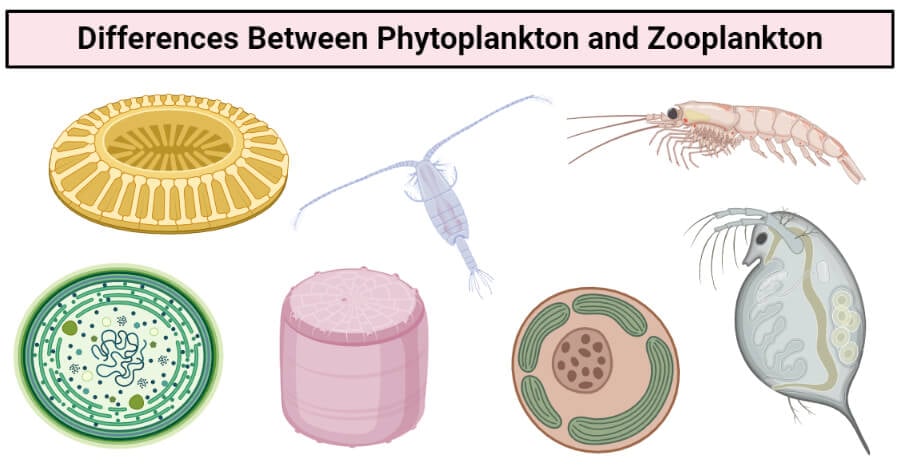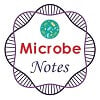
Interesting Science Videos
Phytoplankton Definition
Phytoplankton is a group of free-floating microalgae that drifts with the water current and forms an important part of the ocean, sea, and freshwater ecosystems.
- The term phytoplankton comes from two Greek words, ‘Phyto’ meaning plants, and ‘plankton’ meaning drifter.
- Phytoplanktons are autotrophic as, like land vegetation, they are also provided with chlorophyll to make their own food.
- Most phytoplankton are found floating on the top of water bodies as they require sunlight for their food preparation.
- Individual phytoplanktons are tiny and cannot be seen with the unaided eye, but when present in masses, they appear as colored patches on the water surface.
- Phytoplankton makes up about 1% of the total biomass of the world. These organisms are the primary source of food for most marine and freshwater animals.
- The amount of phytoplankton might change seasonally with the availability of sufficient sunlight, suitable temperature, and other substrates.
- There are diverse groups within phytoplankton consisting of diatoms, cyanobacteria, dinoflagellates, green algae and
- These organisms utilize various inorganic minerals during photosynthesis which are then converted into proteins, carbohydrates, and other nutrients for themselves and other animals.
- Unlike other autotrophs like plants, phytoplankton consists of diverse groups of organisms ranging from archaeal or bacterial prokaryotes to protistan eukaryotes.
- Phytoplankton accounts for half of all the photosynthetic activity throughout the world and is the primary producer in the freshwater and marine food chains.
- These are the key food source in aquaculture and mariculture and are even used as a nutritional supplement for various invertebrates in aquaria.
- However, when the nutrients are available in large quantities, phytoplanktons might grow out of control, resulting in the formation of alga blooms.
- These blooms might produce harmful and even toxic substances that might cause damage to other ecosystems within the habitat.
- Based on studies conducted from 2015 to 2019, it was observed that the phytoplankton concentration is decreasing by about 1% every year as a result of global warming.
- Some examples of phytoplankton include diatoms, green algae, cyanobacteria, and coccolithophores, among others.
Zooplankton Definition
Zooplankton is a group of small and floating organisms that form most of the heterotrophic animals in oceanic environments.
- The term zooplankton comes from two Greek words ‘zoo’ meaning animals and ‘plankton’ meaning drifter.
- Zooplanktons form an integral part of food chains in aquatic environments from freshwater to seas and oceans.
- Because zooplanktons are heterotrophs, they depend on the phytoplankton and other autotrophs for their energy and carbon source.
- Their movement, along with water allows them to find food and also protect themselves from predators.
- Zooplanktons include animals of various sizes ranging from small protozoans to large metazoans. Other animals like young starfish and worms might also act as temporary zooplanktons.
- Zooplanktons, like phytoplanktons, have multiple groups of animals, including radiolarians, foraminiferans, and dinoflagellates, cnidarians, crustaceans, chordates, and molluscs.
- Most zooplanktons are larval forms of fishes and invertebrates that later undergo metamorphosis to change into full-fledged sea creatures.
- The distribution of zooplankton is limited due to various factors like predation, competition, and breeding.
- Additionally, patches of zooplanktons are seen in areas with adequate physical conditions like temperature, water currents, and salinity.
- The number of zooplankton is also limited by the presence of phytoplankton which, in turn, might be disturbed by various other factors, including their lifecycle.
- Zooplanktons are an essential part of ocean food chains as they function as a source of food for higher consumers like fishes.
- These are an important group of animals as they might even function as a conduit for the packaging of organic materials in the biological bumps.
- They also act rapidly against the increasing number of phytoplankton, resulting in blooms, preventing their harmful effects.
- Some zooplanktons have also been associated with the removal of toxic materials like mercury from the pollutants in the water.
- However, zooplanktons also support the survival and transfer of various diseases by housing the pathogenic agents.
- Bacteria like Vibrio cholerae exist in a symbiotic relationship with crustacean zooplanktons as the exoskeleton of such animals provides carbon and nitrogen necessary for the bacterium.
- Some examples of zooplanktons include animals like radiolarians, krill, jellyfish, young molluscs, amphipods, among others.
Key Differences (Phytoplankton vs Zooplankton)
Basis for Comparison |
Phytoplankton |
Zooplankton |
| Definition | Phytoplankton is a group of free-floating microalgae that drifts with the water current and forms an important part of the ocean, sea, and freshwater ecosystems. | Zooplankton is a group of small and floating organisms that form most of the heterotrophic animals in oceanic environments. |
| Terms | ‘Phyto’ refers to ‘plant-like’. | ‘Zoo’ refers to ‘animal-like’. |
| Consists of | Phytoplanktons consist of diatoms, cyanobacteria, dinoflagellates, green algae, and coccolithophores. | Zooplanktons consist of organisms like radiolarians, foraminiferans, and dinoflagellates, cnidarians, crustaceans, chordates, and molluscs. |
| Nutrition | Phytoplanktons are autotrophic and thus, can make their own food with sunlight and chlorophyll. | Zooplanktons are heterotrophic depending on the distribution of phytoplankton for their food and energy. |
| Habitat | Phytoplanktons are found mostly floating on the surface of water bodies as they require sunlight for photosynthesis. | Zooplanktons remain mostly around the dark and deeper areas of water. |
| Appearance | Phytoplanktons are seen as cloudy green patches on water. Otherwise, they appear brown in color. | Zooplanktons are mostly translucent, but their shape, size, and color might differ with the type of the organism. |
| Size | Phytoplanktons are invisible to the unaided eyes and can only be seen as green patches when present in large numbers. | Most zooplanktons are large enough to be seen with naked eyes. |
| Photosynthesis | Phytoplanktons are capable of photosynthesis, being responsible for about half of the photosynthesis performed around the world | Zooplanktons are not capable of photosynthesis. |
| Oxygen release | Phytoplanktons are photosynthetic and thus are extremely important for oxygen release. | Zooplanktons only take in oxygen and do not produce it. |
| Energy | Phytoplanktons obtain their energy via photosynthesis by utilizing inorganic minerals. | Zooplanktons obtain their energy by feeding on phytoplankton. |
| Position in the food chain | Phytoplanktons are the producers of the oceanic food chains. | Zooplanktons are the primary or secondary consumers of the oceanic food chain. |
| Movement | Most phytoplanktons are not capable of freely moving with the water currents. | Zooplanktons are capable of moving with or against water currents against predators or competitors. |
| Metamorphosis | Phytoplanktons do not undergo metamorphosis. | Most zooplanktons are larval forms of fishes and invertebrates that eventually metamorphose to form free-swimming creatures. |
| Vertical migration | Phytoplanktons are not capable of vertical migration. | Zooplanktons are capable of vertical migration in water. |
| Functions | Phytoplanktons act as food for zooplankton and also as the indicators of the health of the marine environments. | Zooplanktons are the indicators of toxic substances present in the ecosystems and also serve as food for higher heterotrophs. |
| Examples | Some examples of phytoplankton include diatoms, green algae, cyanobacteria, and coccolithophores, among others. | Some examples of zooplanktons include animals like radiolarians, krill, jellyfish, young molluscs, and amphipods, among others. |
Examples of phytoplanktons
Cyanobacteria
- Cyanobacteria are the photosynthetic bacteria mostly found in water that utilize sulfur compounds to make their food via chemosynthesis.
- Cyanobacteria are also called blue-green algae as they are autotrophs and are responsible for most of the oxygen produced in the marine environments.
- These form a large group within phytoplankton and are distributed uniformly through all water bodies in the world. Cyanobacteria are found in varying shapes, sizes, and colors as well.
- Most cyanobacteria are well suited for various aquatic environments as they are more resistant than other phytoplanktons and thus can survive even extreme aquatic habitats.
- These exist mostly in colonies consisting of unicellular to filamentous colonies distributed randomly through water bodies.
- Different biomasses are formed in different areas as the colonies separate from each other to inhabit different locations. Some cyanobacteria like Lyngbya might even form blooms.
- Cyanobacteria, like all phytoplanktons, serve as a food source for zooplankton.
- Some examples of cyanobacteria found in oceanic habitats include Synechocystis, Oscillatoria, Lyngbya, etc.
Dinoflagellates
- These are unicellular organisms that appear golden-brown due to the presence of golden-brown plastids.
- Most dinoflagellates form a symbiotic relationship with by taking in inorganic minerals while providing them with sufficient oxygen.
- They have a dented cell membrane and show distinct swimming patterns with a rather large nucleus and visible chromosomes.
- They have two dissimilar flagella protruding from the cell membrane, thus, the name dinoflagellates.
- Even though they are important as a part of phytoplanktons in producing food and oxygen for the environment, these might be harmful if developed into blooms.
- Some of them even produce toxic substances harmful to other animals and plants sharing the habitat.
- Some examples of dinoflagellates include Oxyrrhis marina, Dinophysis acuminate, Symbiodinium, etc.
Examples of zooplanktons
Jellyfish
- Jellyfish is an example of a zooplankton that is capable of both drifting and swimming through oceans.
- There are hundreds of jellyfishes residing in almost all parts of oceans, all belonging to the group called sea anemones or corals.
- Jellyfish are transparent and soft-bodied that appears as an umbrella with tentacles around the edges hanging off of them. The structure is called the medusa.
- The size of jellyfish ranges from being microscopic to some being more than one meter in length.
- Because ocean food chains are comparatively shorter than those on the land, zooplanktons like jellyfish form a connecting link between the phytoplankton and higher animals.
- However, the increase in the number of these jellyfish above normal might also be a problem as some large jellyfish can consume the larva of small fishes.
Krill
- Krill form an important part of zooplanktons that are a type of crustacean found populating oceans throughout the world.
- Krill are found on the surface of the water during the day, but they move towards the deeper areas during nights.
- These usually form a lower trophic level as primary consumers that form a bridge between the phytoplanktons and secondary or tertiary consumers.
- Most krill act as a food source for larger marine animals.
- Some of them are even fished commercially as they can be used as a fooder for aquaculture and mariculture.
- Like most crustaceans, they have a chitinous exoskeleton which is mostly transparent.
- Krill are bioluminescent having organs called photophores that can emit light, possibly important for mating and orientation.
References and Sources
- 1% – https://owlcation.com/stem/What-are-phytoplankton
- 1% – https://oceanservice.noaa.gov/facts/phyto.html
- <1% – https://www.vedantu.com/biology/autotrophic-nutrition
- <1% – https://www.thoughtco.com/all-about-photosynthetic-organisms-4038227
- <1% – https://www.encyclopedia.com/plants-and-animals/microbes-algae-and-fungi/moneran-and-protistan/zooplankton
- <1% – https://link.springer.com/chapter/10.1007%2F978-3-642-19106-0_2
- <1% – https://deepoceanfacts.com/deep-ocean-ecosystems
- <1% – https://climatechangeandoceanstratification.blogspot.com/p/importance-of-phytoplanktons.html
- <1% – https://answers.yahoo.com/question/index?qid=20080902141806AAJSDeL
- <1% – http://docshare.tips/shankar-ias-environment-pdf_5852416eb6d87f6d358b5994.html
